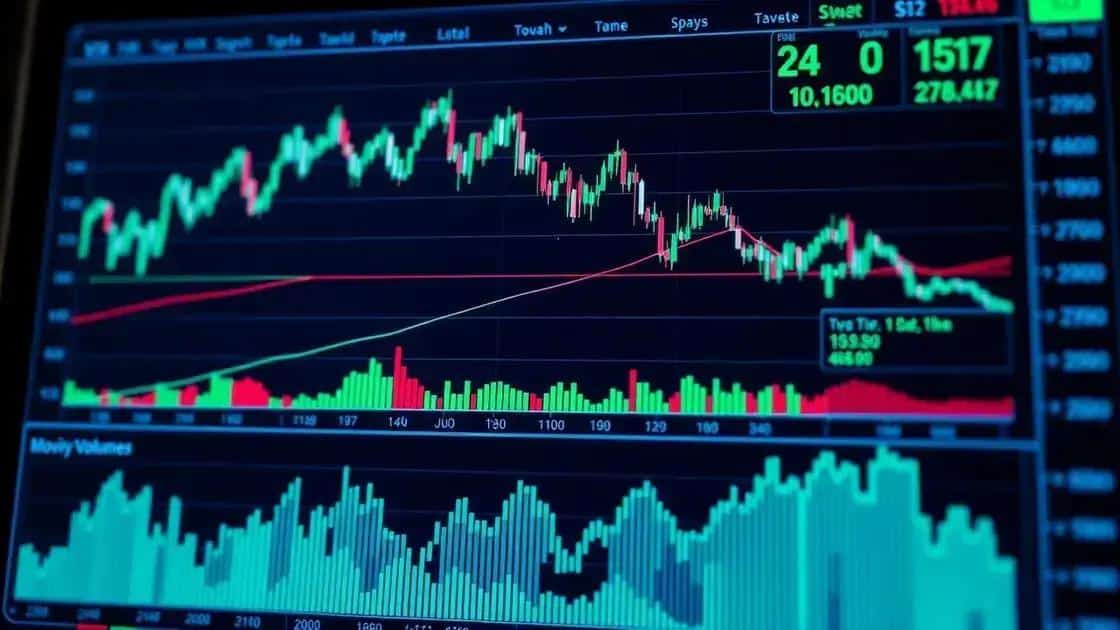Stock market volatility indicators you need to know

Anúncios
Stock market volatility indicators, such as the VIX and moving averages, are essential tools for investors to assess market fluctuations and manage risks effectively.
Stock market volatility indicators play a crucial role in guiding investors through unpredictable market conditions. Curious about how these indicators work and why they matter? Let’s dive in and explore their impact together.
Anúncios
Understanding stock market volatility
Understanding stock market volatility is essential for any investor. It helps you navigate the ups and downs of the market, making your trading experience smoother. Volatility refers to the fluctuation in stock prices over time. High volatility means that prices can change quickly in a short amount of time, which can be both an opportunity and a risk.
What Causes Stock Market Volatility?
Several factors contribute to stock market volatility. These can include economic indicators, geopolitical events, and changes in market sentiment. Here are some key causes:
Anúncios
- Unexpected news that affects the economy.
- Corporate earnings reports.
- Changes in interest rates by the Federal Reserve.
- Political instability.
When these events occur, investors may react quickly, causing stocks to rise or fall. Understanding these triggers can give you an edge when trading in volatile markets.
Measuring Volatility
Investors utilize various tools to measure volatility. Some common methods include:
- Standard Deviation: A statistical measure that shows how much a stock’s price varies from its average.
- Beta: A measure of a stock’s risk in relation to the overall market.
- VIX Index: Often referred to as the “fear index,” it reflects market expectations of near-term volatility.
By using these indicators, you can gauge the level of risk associated with certain stocks and make more informed decisions.
Key indicators of volatility

Key indicators of volatility are crucial for understanding how the stock market behaves during uncertain times. These indicators give investors insights into market sentiment and potential price movements. Volatility indicators can help you make informed decisions and better manage risks.
Understanding the VIX
The VIX, or Volatility Index, is often called the “fear index.” It measures market expectations of future volatility based on S&P 500 index options. When the VIX is high, it suggests that investors expect significant price swings. A low VIX indicates a more stable market. Watching the VIX can help you gauge overall market sentiment.
Using Moving Averages
Another important indicator is the moving average, which helps smooth out price data to identify trends. Common moving averages include:
- 50-day moving average: Used to identify short-term trends.
- 200-day moving average: Indicates long-term trends.
- Exponential moving average: Gives more weight to recent prices.
These moving averages can signal when to buy or sell. They help you understand the market’s direction and its volatility.
Trading Volume as an Indicator
Trading volume is another essential indicator. It shows how much of a security is being traded within a specific time frame. Higher trading volumes often occur during volatile periods. Increased trading volume can validate price movements. If prices rise with high volume, it’s often seen as a strong trend.
By combining these indicators, you can develop a clearer picture of market volatility. This helps in making better investment choices, whether you are looking to seize opportunities or mitigate risks.
How to analyze volatility in real-time
Analyzing volatility in real-time is vital for making quick and informed investment decisions. With the right tools and strategies, you can effectively monitor how the market behaves and respond accordingly. Real-time analysis allows traders to adjust their strategies based on current market conditions.
Using Charting Tools
Charting software can be invaluable for tracking stock movements. These tools provide visual representations of price changes over time. Key features include:
- Candlestick charts: Show price movements within a specific timeframe.
- Line charts: Display the closing prices over time, helping identify trends.
- Volume indicators: Provide insights into the strength of price movements.
By studying these charts, you can see patterns and trends that indicate volatility. Recognizing these can help you make changes to your trading strategy in real time.
Setting Up Alerts
Another effective method is setting up alerts on your trading platform. Alerts inform you when certain price thresholds or volatility levels are reached. This allows you to respond quickly to changing market conditions without the need to monitor prices constantly.
By receiving notifications of significant market movements, you can take advantage of opportunities or limit losses. Combining alerts with your existing analysis will enable you to stay ahead in a fluctuating market.
Utilizing News and Social Media
Real-time analysis isn’t just about numbers. Staying informed about current events is equally important. Financial news agencies and social media platforms can provide timely updates that influence market volatility. Here are a few ways to leverage this information:
- Follow financial news sites for breaking news.
- Monitor economic reports and announcements.
- Use social media to gauge market sentiment and trends.
Integrating news analysis into your real-time monitoring can enrich your understanding of market movements, helping you adjust your strategies promptly.
Strategies to manage volatility risks

Strategies to manage volatility risks are essential for traders and investors looking to protect their portfolios. By understanding and applying these strategies, you can minimize losses and capitalize on market movements. It’s not just about avoiding risks; it’s about being prepared to navigate the ups and downs of the market.
Diversifying Your Portfolio
Diversification is one of the most effective ways to manage risk. By spreading your investments across different asset classes, you can reduce the impact of volatility on your overall portfolio. Key points to consider include:
- Equities: Invest in stocks from different sectors.
- Bonds: Include various types of bonds to balance risk.
- Commodities: Consider investments in physical goods like gold or oil.
- Real Estate: EXplore real estate investments for additional income.
This mix can help stabilize returns during periods of high market volatility.
Using Options to Hedge
Options trading can be a powerful tool for managing risks. By purchasing put options, you have the right to sell a stock at a predetermined price. This can protect you from significant losses if the stock price falls. Other strategies include:
- Covered Calls: Generate income by selling call options on stocks you own.
- Protective Puts: Hedge your long positions to minimize downturn risks.
- Spreads: Use spreads to limit potential losses.
Using these options wisely allows you to safeguard your investments while still participating in market movements.
Staying Informed and Agile
Staying updated with market news and trends is crucial. Economic indicators, earnings reports, and geopolitical events can all impact volatility. By keeping track of these factors, you can make informed decisions quickly. This agility can make a significant difference during turbulent times.
Combine this information with your trading plan to adjust your strategy based on real-time conditions. Being proactive rather than reactive helps in managing risks effectively.
FAQ – Frequently Asked Questions about Stock Market Volatility Indicators
What is stock market volatility?
Stock market volatility refers to the fluctuations in prices of stocks over time, indicating the degree of variation in a market.
How can I manage volatility risks?
You can manage volatility risks through strategies like diversification, options trading, and staying informed about market trends.
What are key indicators of market volatility?
Key indicators include the VIX, moving averages, and trading volume, which help gauge market sentiment and price fluctuations.
Why is real-time analysis important?
Real-time analysis allows investors to react quickly to market changes, making informed decisions that can protect their investments.






